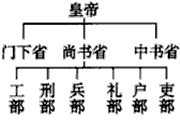阅读材料,回答问题:
材料一 人们全然不可能设想一个比这更好的政府,在那里事无巨细均由相互制约的大衙门审理,……中国的一切都通过这些衙门的自我调节。 ——伏尔泰
材料二 人们曾想使君主以专制主义支配法律,但是任何事物与专制主义联系在一起都会丧失其力量。中国的专制主义在灾难深重的巨大压力下,也曾试图给自己套上锁链,但最终完全徒劳无益;它用自己的锁链武装起自己,而且变得更加凶残。因此,中国是一个以恐怖为原则的专制主义的国家。或许在最初的朝代,帝国的疆域还没有如此广大,政府的专制主义倾向稍逊;而如今的情形就完全不同了。 ——孟德斯鸠《论法的精神》
材料三 究竟是一个党好,还是几个党好?现在看来,恐怕是几个党好。…… * * 党可以监督民主党派,民主党派也可以监督 * * 党。为什么要让民主党派监督 * * 党呢?这是因为一个党同一个人一样,耳边很需要听到不同的声音。 一一毛 * * 《论十大关系》
材料四 看一个政体是不是民主政体,不能看是不是具备了某些形式,关键是要看它是否建立在法治之上,能否建构一种科学的监督机制,能否把民主与集中合理地结合起来……。 ——摘自“对现代国家制度的新思考”(《人民日报》2008年9月26日)

(1)试以上图所示制度的特点论证材料一的观点。
(2)孟德斯鸠极力倡导的“权力制衡”精神,是对上图所示中国大衙门“相互制约”精神的抄袭吗?为什么?
(3)据材料二,指出孟德斯鸠认为中国专制主义加强的原因。他对当时中国政治特点的认识是否符合实际?
(4)材料三体现了新中国的哪项政治制度?结合材料四分析这项政治制度的优越性。
(5)上图和材料三所体现的两种政治模式在形式上有何共性? 概括说明这两种政治模式在本质上的不同。
(1)唐朝的三省六部职权有分工,也有合作,相互牵制和监督,彼此调节和配合,从而使封建官僚机构形成完整严密的体系,提高了行政效率,加强了中央统治力量。
(2)不是。唐朝的“相互制约”是皇权之下中央政府内部的相互制约,是维护封建君主专制的。孟德斯鸠主张的是立法、司法、行政三权彼此独立、互相监督,是对封建制度的否定,是维护民主制度的。(3)原因:专制权力不受约束;帝国的疆域日益扩大。符合实际,当时中国正处在清王朝统治时期,君主专制发展到了顶峰。
(4)政治制度:中 * * 党领导的多党合作和政治协商的政治制度。把民主集中制与科学的监督机制结合起来,具有无可比拟的优越性。
(5)共性:权力的制约与监督。唐朝的三省六部制体现了封建专制统治的特点,政治协商制度体现了社会主义民主政治的特点。
